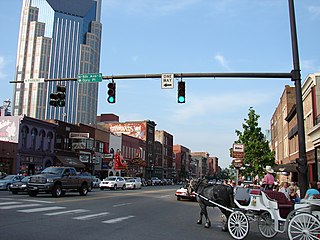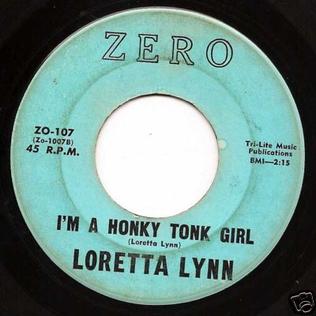
Ernest Dale Tubb, nicknamed the Texas Troubadour, was an American singer and songwriter and one of the pioneers of country music. His biggest career hit song, "Walking the Floor Over You" (1941), marked the rise of the honky tonk style of music.
Outlaw country is a subgenre of American country music created by a small group of iconoclastic artists active in the 1970s and early 1980s, known collectively as the outlaw movement, who fought for and won their creative freedom outside of the Nashville establishment that dictated the sound of most country music of the era. Willie Nelson, Waylon Jennings, Merle Haggard, Johnny Cash, Kris Kristofferson, and David Allan Coe were among the movement's most commercially successful members.
Gary Ronnie Stewart was an American musician and songwriter, known for his distinctive vibrato voice and his outlaw country sound influenced by southern rock. At the height of his popularity in the mid-1970s, Time magazine described him as the "king of honkytonk." He had a series of country chart hits from the mid- to late 1970s, the biggest of which was "She's Actin' Single ", which topped the U.S. country singles chart in 1975.

The lap steel guitar, also known as a Hawaiian guitar, is a type of steel guitar without pedals that is typically played with the instrument in a horizontal position across the performer's lap. Unlike the usual manner of playing a traditional acoustic guitar, in which the performer's fingertips press the strings against frets, the pitch of a steel guitar is changed by pressing a polished steel bar against plucked strings. Though the instrument does not have frets, it displays markers that resemble them. Lap steels may differ markedly from one another in external appearance, depending on whether they are acoustic or electric, but in either case, do not have pedals, distinguishing them from pedal steel guitars.
Western swing is a subgenre of American country music that originated in the late 1920s in the West and South among the region's Western string bands. It is dance music, often with an up-tempo beat, which attracted huge crowds to dance halls and clubs in Texas, Oklahoma and California during the 1930s and 1940s until a federal war-time nightclub tax in 1944 contributed to the genre's decline.

Henry William Thompson was an American country music singer-songwriter and musician whose career spanned seven decades.

John Bush Shinn III was an American country music singer, songwriter, and musician. Nicknamed the "Country Caruso", Bush was best known for his distinctive voice and for writing the song "Whiskey River", a top 10 hit for himself which also became the signature song of fellow country artist Willie Nelson. He was especially popular in his native Texas.

"Honky Tonk Women" is a song by the English rock band the Rolling Stones. It was released as a non-album single on 4 July 1969 in the United Kingdom, and a week later in the United States. It topped the charts in both nations. The song was on Rolling Stone's 500 Greatest Songs of All Time list, and was inducted into the Grammy Hall of Fame.

Neotraditional country is a country music style that emphasizes the instrumental background and a traditional country vocal style. Neotraditional country artists often dress in the fashions of the country music scene of the 1940s, 1950s, and 1960s. Reba McEntire, Alan Jackson, Patty Loveless, George Strait, Randy Travis, and Toby Keith are commonly associated with this style of music. Western music performers of neotraditional style music often emphasize their heritage genres, examples include those associated with the late Al Hurricane in New Mexico music, and modern honky-tonk bands like Midland in the Texas country music scene.
Country USA was a 23-volume series issued by Time-Life Music during the late 1980s and early 1990s, spotlighting country music of the 1950s through early 1970s.
Floyd Tillman was an American country musician who, in the 1930s and 1940s, helped create the Western swing and honky tonk genres. Tillman was inducted into the Nashville Songwriters Hall of Fame in 1970 and the Country Music Hall of Fame in 1984.
The Bakersfield sound is a sub-genre of country music developed in the mid-to-late 1950s in and around Bakersfield, California. Bakersfield is defined by its influences of rock and roll and honky-tonk style country, and its heavy use of electric instrumentation and backbeats. It was also a reaction against the slickly produced, orchestra-laden Nashville sound, which was becoming popular in the late 1950s. The Bakersfield sound became one of the most popular and influential country genres of the 1960s, initiating a revival of honky-tonk music and influencing later country rock and outlaw country musicians, as well as progressive country.

Broadway is a major thoroughfare in the downtown area in Nashville, Tennessee. It includes Lower Broadway, an entertainment district renowned for honky tonks and live country music.

Honky Tonk Masquerade is the second album by country singer-songwriter Joe Ely, released in 1978.

All Time Hits is an album by American country singer Ernest Tubb and His Texas Troubadours, recorded and released in 1960. Despite the album title, it is not a compilation of Tubb's previous hits. The entire album consists of Tubb's covers of songs that had been hits for other country and honky-tonk singers.
Neon Boots Dancehall & Saloon is a Country and Western bar/honky tonk that was founded as the Esquire Ballroom in 1955 by Raymond Proske in Houston, Texas, at 11410 Hempstead northwest of downtown Houston. In the 1970s and 1980s the club was considered the main rival to Gilley's Club across town in Pasadena.
"Let's Turn Back the Years" is a song written and originally recorded by Hank Williams for MGM Records.
"I'm Sorry for You, My Friend" is a song written and recorded by Hank Williams. It was released as the flipside to his single "Honky Tonk Blues" in 1952 on MGM Records.

"I'm a Honky Tonk Girl" is the debut single by American country music artist Loretta Lynn, released in March 1960. The song was among the first to not only be recorded by Lynn, but also to be penned by her. She composed the song while living in Washington State, maintaining her role as a housewife and occasional member of a local country music band. The composition was later recorded in California after Lynn was given money by a local businessman, who was impressed by her singing. "I'm a Honky Tonk Girl" was then issued as a single under the newly founded and independent Zero Records label in March 1960.

Jimmy Day was an American steel guitarist active in the 1950s and 1960s whose career in country music blossomed about the time the pedal steel guitar was invented after pedals were added to the lap steel guitar. He was a pioneer on pedal steel in the genres of Western swing and Honky tonk and his modifications of the instrument's design have become a standard on the modern pedal steel. Day's first job after high school was performing on the Louisiana Hayride as a sideman accompanying developing country artists including Hank Williams, Webb Pierce, Willie Nelson, Jim Reeves, Ray Price and Elvis Presley. He recorded and toured with all these artists and was featured on hit records by of many of them, including Ray Price's, "Crazy Arms" and "Heartaches by the Number". He was a member of Elvis Presley's band for about a year, but, along with fellow bandmate Floyd Cramer, resigned after Presley requested them to re-locate to Hollywood; instead, Day moved to Nashville to work as a session player and Grand Ole Opry musician. He was a member of the Western Swing Hall of Fame (1994) and the International Steel Guitar Hall of Fame (1999). Day died of cancer in 1999.












